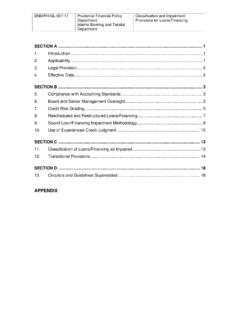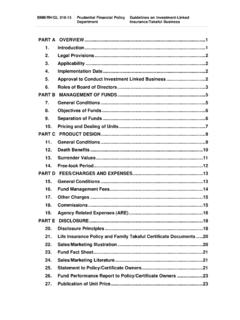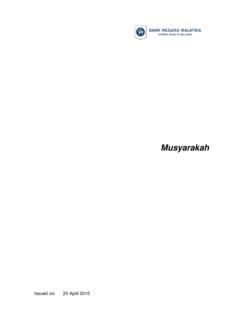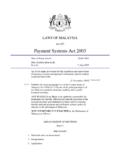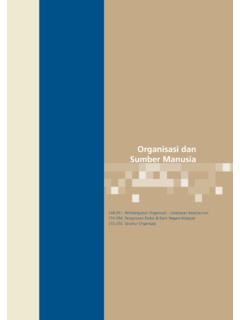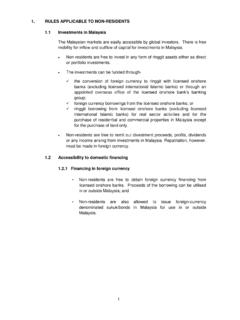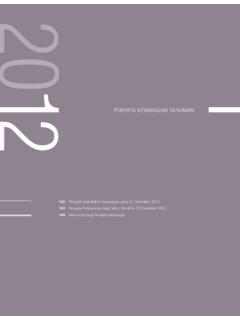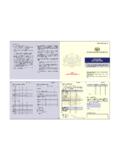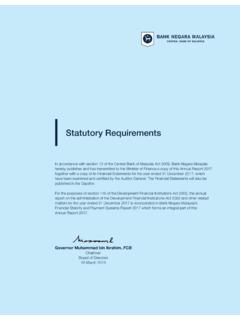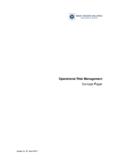Transcription of SUMMARY1 PART A: INTRODUCTION3 PART B: APPROACH …
1 PART A: Overview and Objective of the Role of Stress Licensed Effective Legal PART B: APPROACH TO STRESS TEST BY LICENSED Coverage and Risk Magnitude of Second-Round PART C: SPECIFIC REQUIREMENTS BY BANK NEGARA Licensed Institutions Should Conduct Own Stress Effective Board and management Minimum Requirements for Stress Tests Conducted by Licensed Reporting to Bank Negara Appendix Appendix Appendix Appendix BNM/RH/GL 007 - 3 Jointly issued by: Financial Conglomerate Supervision Department; and banking Supervision Department Guideline on Stress Testing Page 1/34 SUMMARY 1.
2 The guideline reinforces the importance of stress testing as a risk management tool used to evaluate the potential effects on an institution s financial condition arising from a specific event or movement in a set of financial variables. Licensed institutions should determine their own strategies for designing and developing stress testing methods that are relevant and effective for their business environment and profile. 2. The role of management is crucial in making the stress test an integral part of the institution s risk management . The management is responsible for the overall framework, identifying potential stress scenarios, taking remedial measures or actions where warranted, given the institution s risk appetite and business strategy.
3 This is especially pertinent since much of the value in stress testing is derived from internal discussion of which stress scenarios imply the greatest vulnerability. 3. Licensed institutions are encouraged to explore, design and develop stress tests that would be most appropriate and effective for their business environment and profile. For instance, sophisticated and complex institutions should use a combination of both scenario and sensitivity analysis with greater coverage across product lines or geographical regions and consider secondary effects. Less complex institutions may, considering their risk profile, confine themselves to simple scenario tests that can be run relatively quickly and can be used by the management to form a view of the impact of a small number of variables on the financial condition of the institution.
4 However, the appropriateness of the stress tests will be assessed based on the scale and complexity of the licensed institution s business and risk profile. 4. Bank Negara Malaysia remains cognizant of the evolving standards. Hence, in certain areas Bank Negara Malaysia is not specifying any common BNM/RH/GL 007 - 3 Jointly issued by: Financial Conglomerate Supervision Department; and banking Supervision Department Guideline on Stress Testing Page 2/34 methodologies nor prescribing any methods such as the second round effect and aggregation of risks .
5 The main objectives are to ensure that all material risks are captured, reasons for the loss outcomes are identified and management are able to make informed decisions based on the stress test results. To facilitate the above, stress testing should be integrated into the institution s risk management framework. It is envisaged that licensed institutions will improve the sophistication of their stress test programme over time. BNM/RH/GL 007 - 3 Jointly issued by: Financial Conglomerate Supervision Department; and banking Supervision Department Guideline on Stress Testing Page 3/34 PART A: INTRODUCTION The primary objective of the Guideline on Stress Testing (the Guideline) is to reinforce the importance of stress testing as a risk management tool.
6 The Guideline provides guidance and principles on the critical areas pertaining to stress testing as well as specific requirements that is expected of licensed institutions. Stress testing has become a standard risk management tool for licensed institutions to understand the nature of their risk profile and the risk drivers. Stress testing involves identifying possible events or future changes in the financial and economic conditions that could have unfavourable effects on a licensed institution s exposure and the assessment of the licensed institution s ability to withstand such changes1, usually in relation to the capacity of its capital and earnings to absorb potentially significant losses.
7 Steps are then identified to manage the risks and conserve capital. Stress testing can be applied in identifying potential vulnerable risk areas of a licensed institution s portfolio to exceptional but plausible events. It examines an alternative future that could cause problems in the portfolio, thus enabling a licensed institution to determine how bad those problems could become and prepare for them. 1 International Convergence of Capital Measurement and Capital Standards, BIS (June 2004) . Overview and Objective of the Guideline Role of Stress Testing BNM/RH/GL 007 - 3 Jointly issued by: Financial Conglomerate Supervision Department; and banking Supervision Department Guideline on Stress Testing Page 4/34 In addition, by applying these exceptional but plausible events to the portfolio, stress tests can also be utilized to better understand the risk profile, evaluate business risks and thus take appropriate measures accordingly.
8 The Basel Committee on banking Supervision also recognises the importance of stress testing. The revised framework on International Convergence of Capital Measurement and Capital Standards (June 2004) specifically provides that sound stress testing processes must be in place for use in the assessment of capital adequacy. Stress testing should be both rigorous and forward looking. The stress testing methodology must be flexible so that it can be adapted quickly and efficiently to the changing environment. It should also be comprehensive so that the breadth and scale of different businesses undertaken by the licensed institutions can be captured.
9 The role of stress testing can be expanded to serve as a business decision making tool where analysis from stress test results may guide licensed institutions in the process of undertaking new business activities, entering new markets or undertaking strategic initiatives for example, mergers and acquisitions. Stress tests are employed to assess the effect of tail events beyond the level of confidence assumed in statistical models. This is because in times of stress there is less predictability in the behaviour of risk factors, breakdown of correlations, sudden illiquidity in the markets, rapid price movements and the contagion impact on other markets and economies.
10 In this sense, stress tests complement statistical models such as value-at-risk which are used to predict maximum loss in normal business conditions. Stress testing can also be used in portfolios that lack historical data. These are portfolios with insufficient data for construction of statistical models or there is tendency for market gaps or difficulty in estimating non-linear relationships. BNM/RH/GL 007 - 3 Jointly issued by: Financial Conglomerate Supervision Department; and banking Supervision Department Guideline on Stress Testing Page 5/34 The Guideline is applicable to the following licensed institutions: Commercial banks, finance companies and merchant banks / investment banks licensed under the banking and Financial Institutions Act 1989 (BAFIA); Islamic banking institutions licensed under the Islamic banking Act 1983; and Any other licensed institution specified by Bank Negara Malaysia.
